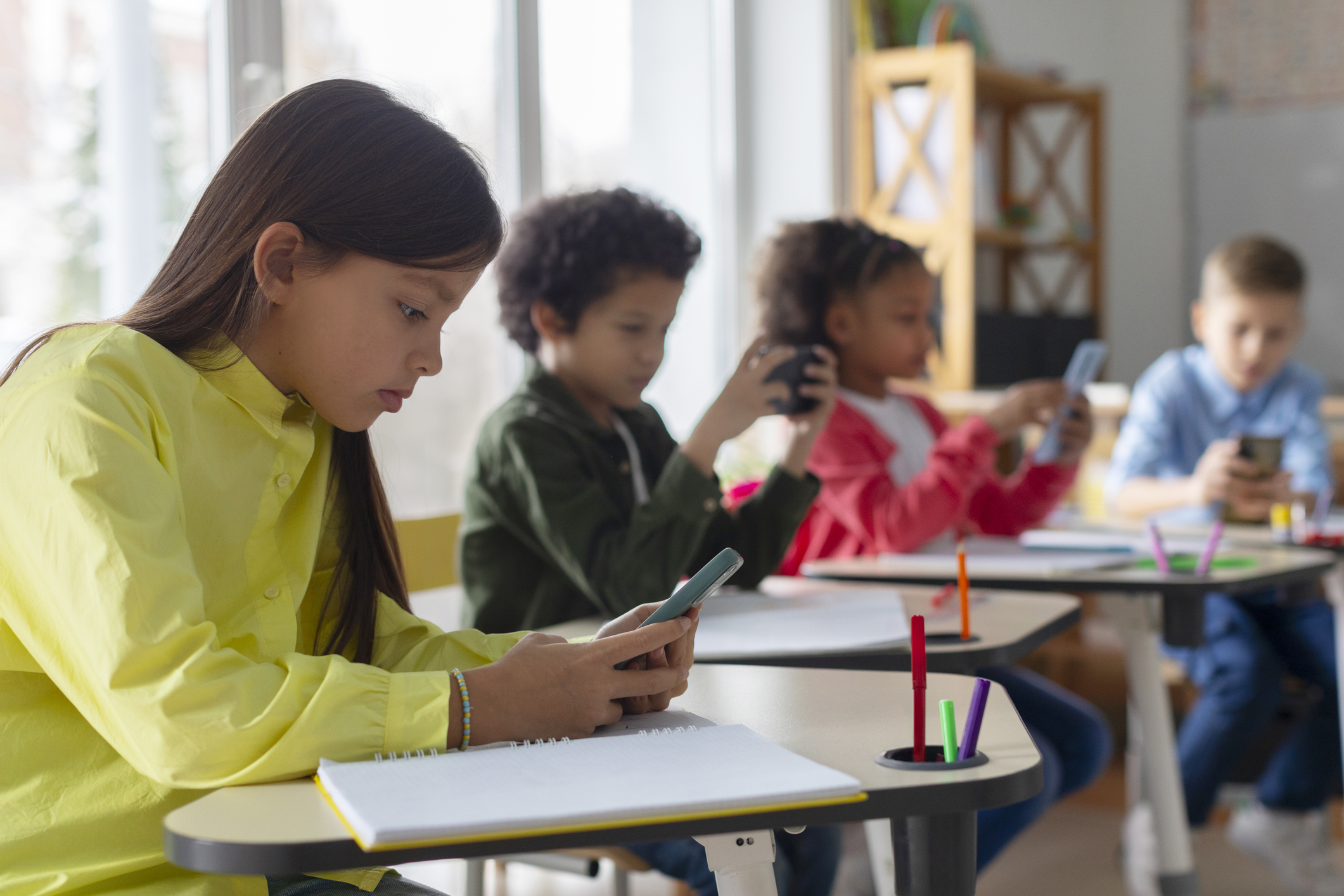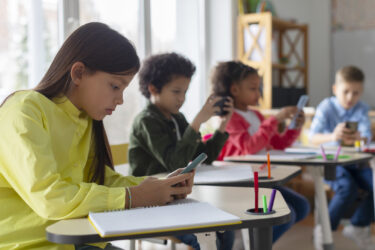Curbing Cell Phone Use in Classrooms

Almost all 11- to 17-year-olds with smartphones use them regularly in school, for a median 43 minutes per school day. Teachers and school leaders call this use a major distraction from learning.[1] Many state and local authorities have responded by restricting the devices at school, and others are mulling doing so. Many have found stakeholder input critical in devising nuanced, effective policies.
In a Pew Research Center poll, 72 percent of US high school teachers identify students’ cell phone distractions as a major issue.[2] Teachers observe frequent multitasking, reduced collaboration, and challenges to classroom authority. According to the National Center for Education Statistics, more than half of public school leaders say cell phones hurt academic performance.[3]
Stakeholders have expressed concerns that extend beyond the impact on academics, including risks to students’ safety and mental health from the use of cell phones to access social media. Pew reports that 96 percent of youth ages 13-17 report using social media, with 46 percent saying they use it “almost constantly.”[4] In 2023, a Surgeon General’s advisory cited research pointing to both harms and benefits from youth engagement with social media. The advisory urged policymakers to do more to ensure online safety and implement digital literacy standards and curricula to help children learn to reduce online risks.[5]
A pilot study of digital use and well-being among 11- to 13-year-olds in Florida suggested that specific digital behaviors, rather than smartphone ownership alone, were associated with adverse mental health outcomes, such as anxiety and depression, in adolescents. It also concluded that even modest amounts of cyberbullying were harmful but that this harm was not limited to students owning smartphones.[6]
Such findings suggest that bans of devices during the school day alone will not address the complicated, potential harms arising from students’ online behaviors, nor help them learn skills for appropriate use. “We need to pair a ban or restriction with media literacy classes and equipping students with skills to succeed in a digitally dominant place,” said Julia Clauson, California State Board of Education’s student member in 2024–25.
States’ Approaches
State policymakers have responded to concerns about students’ use of cell phones and other personal electronic devices in different ways. Some states let districts adopt their own policies. Still others want to be sure that personal devices can be used to advance instruction and do so equitably.
As of April 2025, at least 31 states and the District of Columbia have adopted statewide bans or restrictions regarding use of personal electronic devices.[7] Legislators and state education agencies have set rules districts should follow or required simply that districts have policies in place. There are protocols for cell phone use at 86 percent of elementary schools and 55 percent of high schools.
As of April 2025, at least 31 states and the District of Columbia have adopted statewide bans or restrictions regarding use of personal electronic devices.
Colorado requires districts and certain charter schools to adopt a policy on student use of a “communication device” without specifying what that policy must entail. In Alabama, legislators opted to ban students’ use of wireless communication devices at schools completely. In a middle-ground policy, North Carolina districts are to “adopt a cell phone–free education policy to eliminate or severely restrict student access to cell phones during instructional time.”[8]
In 2024, the Connecticut state board adopted a position statement and policy guidance on the impact of social media and cell phone use on student learning and mental health.[9] Rather than banning cell phones, the guidance recommends districts restrict the use of cell phones and smartwatches during the school day to encourage student engagement, well-being, interpersonal skills, peer interaction, and social communication.
The input of students, teachers, and parents resulted in greater flexibility and adaptations for different grade levels. “Our students opened up our eyes,” said Erin Benham, vice chair of the state board. “It was good to see that an exception was made.” Policymakers realized that top-down mandates may not account for rural and urban differences or varying school resources, she said.
The input of students, teachers, and parents resulted in greater flexibility and adaptations for different grade levels.
Yet teachers also spoke to the urgency of having guidance. They cited frequent multitasking, reduced collaboration, and challenges to classroom authority, Benham said. Teachers also noted that many parents fail to understand what phone-related distractions look like in practice: not just that students are texting but that they listen to music with phones hidden in their clothes, watch videos, or record others without consent.
The District of Columbia state board adopted a resolution in February 2025 calling for the elimination of cell phone use during the school day. The board had earlier gathered insights from its Student Advisory Committee, teachers, families, and experts. Educators said phones were disrupting learning and impairing student well-being. Student board members raised concerns about technology equity, funding, and emergency communications.[10]
The Kansas state board established a blue ribbon task force in July 2024 that included students. It developed nonbinding recommendations for districts on personal device use in school, screen time and mental health, and parental oversight.[11] In July 2025, the state board heard the results of a survey in which most district leaders reported they had personal device policies in place and that they believed the policies improved classroom engagement and reduced distractions.
Safety and Mental Health
Many parents have expressed concern that cell phone bans will make it impossible to reach their children during an emergency. But law enforcement and first responders say that students’ phones can complicate emergency response. Benham explained this concern: “When students go into [emergency] drills, their phones need to be not live. If their phones are ringing, it is a dead giveaway where they are.” Thus, phone restrictions may keep students safer.
Cyberbullying is another key reason raised for restricting cell phone use, as nine in ten public schools report occurrences of cyberbullying among students.[12] A study conducted by the Cyberbullying Research Center found that over 34 percent of students ages 12-17 have experienced cyberbullying, with many incidents occurring during school hours.[13]
Over 34 percent of students ages 12-17 have experienced cyberbullying, with many incidents occurring during school hours.
Such online interactions, along with access to other nefarious online actors and content, imperil students’ mental health. Clauson noted she had observed mental health impacts in her peers in California.
Many parents lack the digital literacy skills to monitor their children’s phone use effectively, said Kentucky state board member Julie Pile, cofounder of the nonprofit ParentCamp. Parents often look to district leaders for guidance around limiting phone use, she added.
Ian House, student member of the North Carolina state board, noted other downsides to student cell phone use. He said students in his state have used cell phones to cheat and that he fears phone access may be inhibiting students’ in-person interactions.
Phones as Instructional Tools
Educators and policymakers also highlight cell phones’ potential for supporting equity, accessibility, and deeper learning. Connecticut teachers helped their state board understand the ways in which phone use supports the curriculum in, for example, real-time simulations and research. Benham further urged state boards to ask how a cell phone ban may widen disparities. They should ask, “Do all students have access to technology? What happens in classes when students don’t have access?” she said.
Connecticut teachers helped their state board understand the ways in which phone use supports the curriculum in, for example, real-time simulations and research.
For example, “policymakers need to consider … students with medical conditions who need access to their cell phones and medical technology,” said Ioannis Asikis, Massachusetts’s student board member.
“Are students using phones as a translation device or [because it assists them with overcoming] a disability?” Clauson asked. She encouraged leaders to ask, “How can we create environments where technology serves learning but doesn’t disrupt it? What [policies] are we pairing with that?”
“Some schools don’t have one-to-one technology, and you do not want to hamper opportunities for kids because they don’t have access to tech,” Pile said. She urged consultation with parents of English learners, neurodivergent children, or students juggling family responsibilities.
Seeking Broad Input
State boards are well positioned to create guardrails to help school districts make informed decisions. Members who have adopted cell phone policies say that the most effective ones are working, flexible frameworks that evolve with input and accommodate ways to create vibrant, distraction-free classrooms without shutting the door on student, parent, teacher, and local needs.
State boards are well positioned to create guardrails to help school districts make informed decisions.
“Do not rush it,” said Montana student board member Gavin Mow. “It is a major issue but not something worth causing an uproar in schools immediately…. You need to hear students and teachers’ experiences on what they think could be done.”
Cell phone restrictions can restore focus, safety, and well-being in classrooms. When paired with media literacy education and shaped by student, teacher, and parent input, these policies can create healthy learning environments without disregarding equity or access.
Naomi Porter is a NASBE intern.
Notes
[1] Jenny S. Radesky et al., “Constant Companion: A Week in the Life of a Young Person’s Smartphone Use,” report (Common Sense, 2023).
[2] Jenn Hatfield, “72% of U.S. High School Teachers Say Cellphone Distraction Is a Major Problem in the Classroom,” Short Reads (Pew Research Center, June 12, 2024).
[3] National Center for Education Statistics, “More than Half of Public School Leaders Say Cell Phones Hurt Academic Performance,” press release, February 19, 2025.
[4] Michelle Faverio and Olivia Sidoti, “Teens, Social Media, and Technology 2024,” report (Pew Research Center, December 12, 2024).
[5] US Public Health Service, “Social Media and Youth Mental Health: The US Surgeon General’s Advisory” (2023). See also, Celina Pierrottet, “Six Questions to Advance Media Literacy and Digital Citizenship,” Power of the Question 7, no. 1 (NASBE, April 2024); American Psychological Association, “Health Advisory on Social Media Use in Adolescence” (May 2023).
[6] J.D. Martin et al., “The Life in Media Survey: A Baseline Study of Digital Media Use and Well-Being among 11- to 13-Year-Olds” (University in South Florida and Harris Poll, 2025). The authors plan to follow a national sample over 25 years using the pilot methodology.
[7] Arianna Prothero, Lauraine Langreo, and Alyson Klein, “Which States Ban or Restrict Cellphones in Schools?” Education Week, updated July 17, 2025.
[8] Ben Humphries and Chantal Brown, “Bills to Restrict Cellphones in NC Classrooms Pass Committees with Bipartisan Support,” EdNC, February 26, 2025.
[9] Connecticut State Board of Education, “Personal Technology Use in Connecticut Schools: Impact of Social Media and the Use of Cell Phones on Student Learning and Mental Health,” position statement and policy guidance (August 2024). The guidance includes references and resources that informed the board’s position.
[10] DC State Board of Education, “State Board Calls for Cellphone Restrictions, School HVAC Improvements and Legacy Admissions Ban,” press release, February 21, 2025).
[11] Kansas State Department of Education, “Blue Ribbon Task Force on Student Screen Time,” report (November 8, 2024).
[12] Nirmita Panchal and Sasha Zitter, “A Look at State Efforts to Ban Cellphones in Schools and Implications for Youth Mental Health,” post (KFF, September 5, 2024).
[13] Justin W. Patchin and Sameer Hinduja, “Summary of Our Cyberbullying Research (2007–2021),” post (Cyberbullying Research Center, June 30, 2025).

 i
i
 i
i
